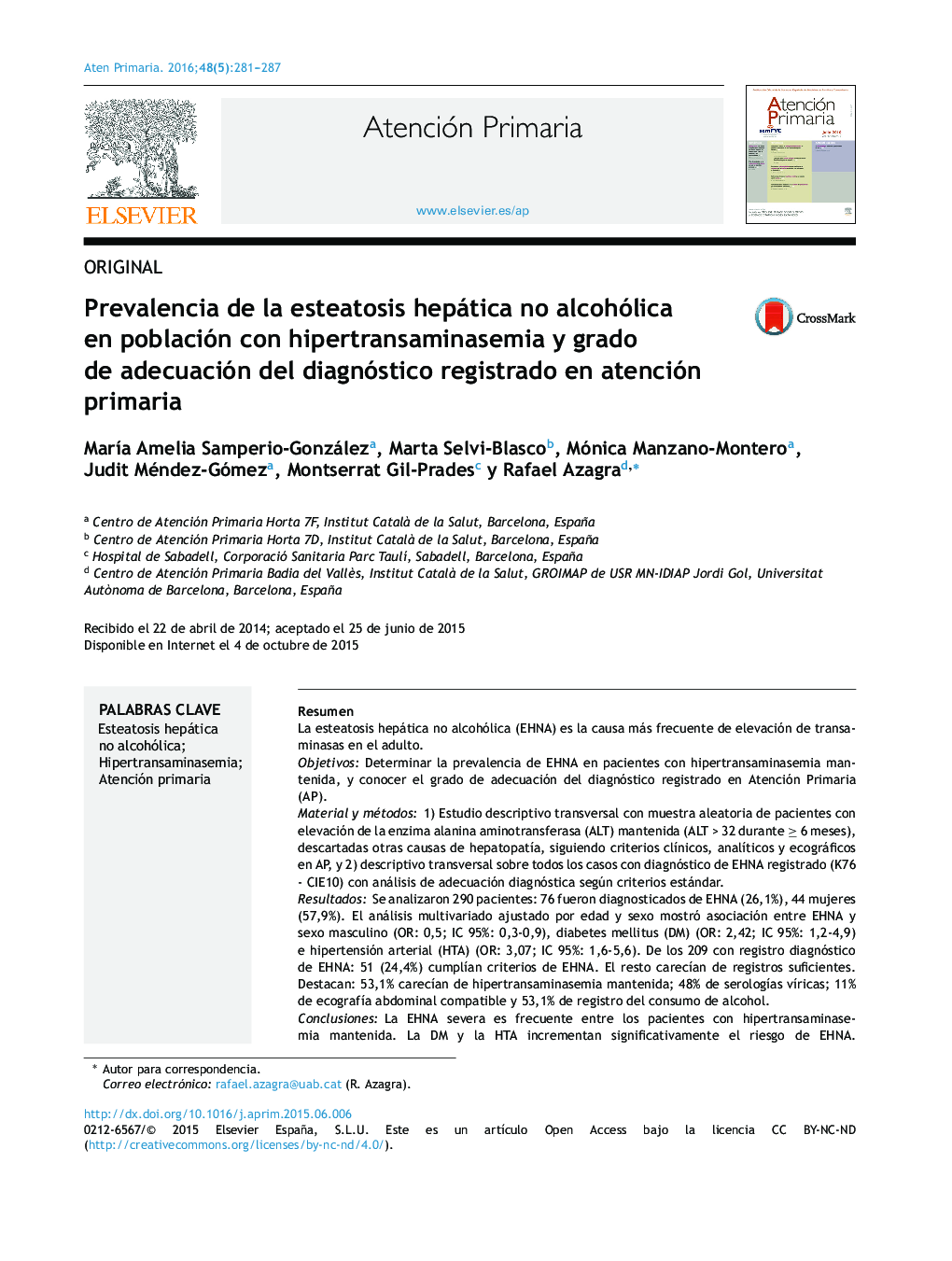| Article ID | Journal | Published Year | Pages | File Type |
|---|---|---|---|---|
| 3456963 | Atención Primaria | 2016 | 7 Pages |
ResumenLa esteatosis hepática no alcohólica (EHNA) es la causa más frecuente de elevación de transaminasas en el adulto.ObjetivosDeterminar la prevalencia de EHNA en pacientes con hipertransaminasemia mantenida, y conocer el grado de adecuación del diagnóstico registrado en Atención Primaria (AP).Material y métodos1) Estudio descriptivo transversal con muestra aleatoria de pacientes con elevación de la enzima alanina aminotransferasa (ALT) mantenida (ALT > 32 durante ≥ 6 meses), descartadas otras causas de hepatopatía, siguiendo criterios clínicos, analíticos y ecográficos en AP, y 2) descriptivo transversal sobre todos los casos con diagnóstico de EHNA registrado (K76 - CIE10) con análisis de adecuación diagnóstica según criterios estándar.ResultadosSe analizaron 290 pacientes: 76 fueron diagnosticados de EHNA (26,1%), 44 mujeres (57,9%). El análisis multivariado ajustado por edad y sexo mostró asociación entre EHNA y sexo masculino (OR: 0,5; IC 95%: 0,3-0,9), diabetes mellitus (DM) (OR: 2,42; IC 95%: 1,2-4,9) e hipertensión arterial (HTA) (OR: 3,07; IC 95%: 1,6-5,6). De los 209 con registro diagnóstico de EHNA: 51 (24,4%) cumplían criterios de EHNA. El resto carecían de registros suficientes. Destacan: 53,1% carecían de hipertransaminasemia mantenida; 48% de serologías víricas; 11% de ecografía abdominal compatible y 53,1% de registro del consumo de alcohol.ConclusionesLa EHNA severa es frecuente entre los pacientes con hipertransaminasemia mantenida. La DM y la HTA incrementan significativamente el riesgo de EHNA. El diagnóstico de EHNA se registra sin considerar todos los criterios de EHNA y se hace mayoritariamente por ecografía. Se deberían unificar criterios diagnósticos en el registro de la EHNA.
Nonalcoholic fatty liver disease (NAFLD) is the most common cause of elevated transaminases in adults.AimDetermine the prevalence of NASH in patients with sustained hypertransaminasemia, and Know the adequacy of the registered in Primary Care (AP) diagnosis.Material and methods1) Cross-sectional study with a random sample of patients with elevated alanine aminotransferase (ALT) held (ALT> 32 for ≥6 months), ruling out other causes of liver disease, according to clinical, laboratory and ultrasound scan criteria in AP and 2) cross-sectional description of all cases diagnosed with NASH recorded (K76 - ICD10) with diagnostic adequacy analysis according to standard criteria.Results290 patients were analyzed: 76 were diagnosed as NASH (26.1%), 44 women (57.9%). Multivariate analysis adjusted for age and sex showed no association between NASH and male gender (OR: 0.5; CI95%: 0.3-0.9), diabetes mellitus (DM) (OR: 2.42; CI95%: 1.2-4.9) and hypertension blood pressure (HBP) (OR: 3.07; CI 95% 1.6-5.6). Of the 209 diagnosed with NASH record: 51 (24.4%) met the criteria for NASH. The rest had insufficient records. Highlights: 53.1% lacked sustained hypertransaminasemia; 48% of viral serology; 11% supported and 53.1% abdominal ultrasound registration of alcohol.ConclusionsSevere NASH is frequent among patients with sustained hypertransaminasemia. The DM and hypertension significantly increase the risk of NASH. The diagnosis of NASH is recorded without considering all criteria and mainly NASH made by ultrasonography. They should unify diagnostic criteria in the register of NASH.
